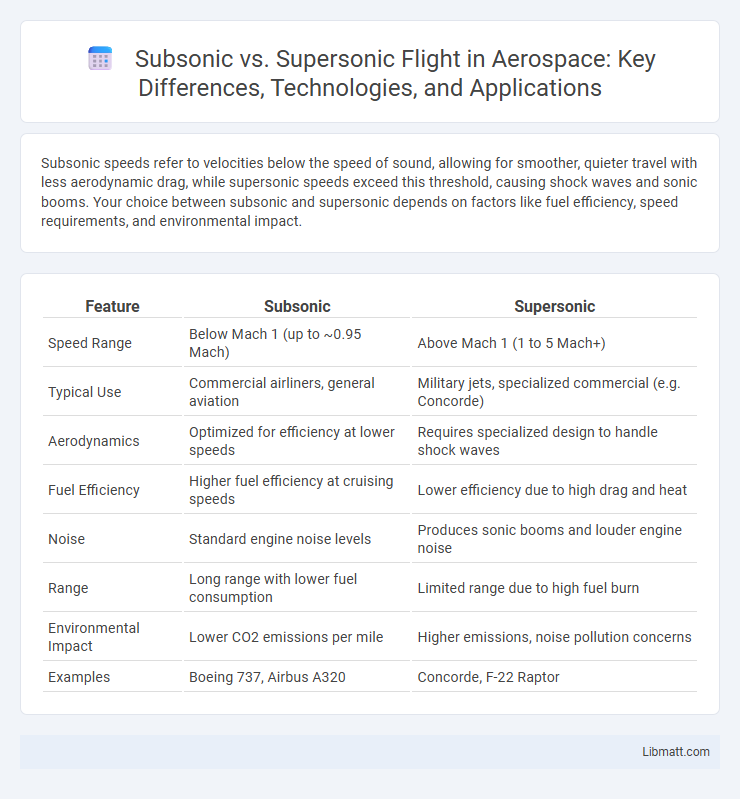Subsonic speeds refer to velocities below the speed of sound, allowing for smoother, quieter travel with less aerodynamic drag, while supersonic speeds exceed this threshold, causing shock waves and sonic booms. Your choice between subsonic and supersonic depends on factors like fuel efficiency, speed requirements, and environmental impact.
Table of Comparison
| Feature | Subsonic | Supersonic |
|---|---|---|
| Speed Range | Below Mach 1 (up to ~0.95 Mach) | Above Mach 1 (1 to 5 Mach+) |
| Typical Use | Commercial airliners, general aviation | Military jets, specialized commercial (e.g. Concorde) |
| Aerodynamics | Optimized for efficiency at lower speeds | Requires specialized design to handle shock waves |
| Fuel Efficiency | Higher fuel efficiency at cruising speeds | Lower efficiency due to high drag and heat |
| Noise | Standard engine noise levels | Produces sonic booms and louder engine noise |
| Range | Long range with lower fuel consumption | Limited range due to high fuel burn |
| Environmental Impact | Lower CO2 emissions per mile | Higher emissions, noise pollution concerns |
| Examples | Boeing 737, Airbus A320 | Concorde, F-22 Raptor |
Understanding Subsonic and Supersonic Speeds
Subsonic speeds refer to velocities slower than the speed of sound, typically less than 767 miles per hour (1,235 kilometers per hour) at sea level, where airflow remains smooth around an object. Supersonic speeds exceed this threshold, causing shock waves and sonic booms due to air pressure changes as an object moves faster than sound. Understanding these differences helps optimize aircraft design and performance for Your specific travel and operational needs.
Key Differences Between Subsonic and Supersonic Flight
Subsonic flight operates at speeds below the speed of sound, typically under Mach 1, resulting in smoother airflow and less aerodynamic stress on the aircraft. Supersonic flight exceeds Mach 1, creating shock waves and sonic booms due to the aircraft breaking the sound barrier, which demands specialized design features like swept wings and reinforced structures. The key differences lie in speed thresholds, aerodynamic challenges, and noise generation, with supersonic aircraft requiring advanced materials and engineering to manage heat and sonic impact.
Physics Behind Subsonic and Supersonic Motion
Subsonic motion occurs when an object travels below the speed of sound, approximately 343 meters per second at sea level, where air pressure waves move ahead of the object smoothly. Supersonic motion surpasses this speed, causing shock waves or sonic booms as pressure waves merge and form a distinct boundary known as the shock front. Understanding the physics behind these motions involves analyzing air resistance, compressibility effects, and changes in aerodynamic forces that directly impact your experience of speed and sound.
Advantages of Subsonic Flight
Subsonic flight offers significant fuel efficiency and lower operating costs compared to supersonic speeds, making it ideal for commercial aviation and long-distance travel. The reduced aerodynamic drag at subsonic speeds enhances aircraft range and minimizes engine wear, contributing to environmental sustainability by lowering carbon emissions. Additionally, subsonic aircraft experience less structural stress, increasing safety and longevity of airframes.
Benefits of Supersonic Travel
Supersonic travel reduces flight times significantly by exceeding the speed of sound, allowing passengers to reach distant destinations faster and more efficiently. The increased speed enhances productivity and convenience, making it ideal for business travelers and urgent transportation needs. Your experience benefits from cutting-edge technology that improves flight performance and passenger comfort during supersonic journeys.
Technological Challenges in Supersonic Aviation
Supersonic aviation faces significant technological challenges, including managing extreme aerodynamic heating and sonic boom mitigation to ensure environmental and passenger safety. Advances in materials science play a crucial role in developing heat-resistant airframes capable of withstanding temperatures exceeding 1,000 degrees Celsius at speeds above Mach 1. Your understanding of these innovations is key to appreciating how engineers balance performance with regulatory and environmental constraints in supersonic flight.
Efficiency and Fuel Consumption: Subsonic vs Supersonic
Subsonic aircraft operate at speeds below the speed of sound, generally resulting in higher fuel efficiency due to lower drag and optimized engine performance, making them suitable for longer, cost-effective flights. Supersonic planes, traveling faster than Mach 1, experience increased aerodynamic drag and shock waves, leading to significantly higher fuel consumption per mile despite shorter travel times. Advances in aerodynamics and materials aim to improve supersonic efficiency, but subsonic jets remain more economical for mass commercial transportation.
Noise and Environmental Impact Comparison
Subsonic aircraft generate lower noise levels due to slower speeds and smoother airflow, resulting in less disruptive sound footprints around airports and urban areas. Supersonic jets produce intense sonic booms and higher environmental noise pollution, challenging regulatory limits and community acceptance. The environmental impact of supersonic travel also includes increased fuel consumption and higher emissions, contributing more significantly to atmospheric pollution compared to subsonic aircraft.
Current and Future Applications of Each Speed Range
Subsonic speeds, typically below Mach 1, dominate commercial aviation due to fuel efficiency and noise regulations, with aircraft like the Boeing 737 and Airbus A320 widely used for passenger and cargo transport. Supersonic speeds, exceeding Mach 1, are primarily utilized in military jets such as the F-22 Raptor and experimental aircraft like the Boom Supersonic Overture, aiming to revolutionize future commercial travel by drastically reducing flight times. Emerging technologies in materials and propulsion systems are poised to expand supersonic and even hypersonic applications, including faster global logistics, missile defense, and space access.
The Future of Subsonic and Supersonic Transportation
Subsonic transportation, characterized by speeds below the speed of sound (Mach 1), remains the backbone of commercial aviation due to its fuel efficiency and established infrastructure. Supersonic travel, exceeding Mach 1, promises to revolutionize global connectivity with drastically reduced flight times, driven by advances in aerodynamics and sustainable fuels. Your future travel options will likely include a blend of both, where subsonic aircraft provide cost-effective routes and supersonic jets offer premium, rapid transit on high-demand corridors.
Subsonic vs Supersonic Infographic

 libmatt.com
libmatt.com